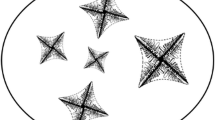Abstract
A general micro/macroscopic model of solidification for 2-D or 3-D castings, valid for both dendritic and eutectic equiaxed alloys, is presented. At the macroscopic level, the heat diffusion equation is solved with an enthalpy formulation using a standard FEM implicit scheme. However, instead of using a unique relationship between temperature and enthalpy (i.e., a unique solidification path), the specific heat and latent heat contributions, whose sum equals the variation of enthalpy at a given node, are calculated using a microscopic model of solidification. This model takes into account nucleation of new grains within the undercooled melt, the kinetics of the dendrite tips or of the eutectic front, and a solute balance at the scale of the grain in the case of dendritic alloys. The coupling between macroscopic and microscopic aspects is carried out using two time-steps, one at the macroscopic level for the implicit calculation of heat flow, and the other, much finer, for the microscopic calculations of nucleation and growth. This micro/macroscopic approach has been applied to one-dimensional and axisymmetric castings of Al-7 pct Si alloys. The calculated recalescences and grain sizes are compared with values measured for one-dimensional ingots cast under well-controlled conditions. Furthermore, the influence of casting conditions on temperature field, undercooling, grain size, and microstructural spacings is shown to be predicted correctly from axisymmetric calculations with regard to the expected experimental behavior.
Similar content being viewed by others
References
W.D. Murray and F. Landis:Trans. ASME, May 1959, pp. 106–12.
P.R. Sahm and P.N. Hansen:Numerical Simulation and Modeling of Casting and Solidification Processes for Foundry and Cast House, Comité International des Associations Techniques de Fonderie, 1984.
W.S. Hwang and R.A. Stoehr:J. of Metals, 1983, vol. 10, pp. 22–29.
S.D. Ridder, S. Kou, and R. Mehrabian:Metall. Trans. B, 1981, vol. 12B, pp. 435–47.
V.R. Voller: inNumerical Methods in Thermal Problems, R.W. Lewis, K. Morgan, and W.G. Habashi, eds., Pineridge Press, Swansea, 1987, vol. V, pp. 693–704.
W. Oldfield:ASM Transaction., 1966, vol. 59, pp. 945–61.
D.M. Stefanescu and C. Kanetkar: inComputer Simulation of Microstructural Evolution, D.J. Srolovitz, ed., TMS-AIME, 1986, pp. 171–88.
I.L. Svensson and E. Lundback: inState of the Art of Computer Simulation of Casting and Solidification Processes, Proc. E-MRS Conference, H. Fredriksson, ed., Les Editions de Physique, Strasbourg, 1986, pp. 57–64.
K.C. Su, I. Ohnaka, I. Yamauchi, and T. Fukusako: inThe Physical Metallurgy of Cast Iron, H. Fredriksson and M. Hillert, eds., North-Holland, 1985, pp. 181–89.
I. Maxwell and A. Hellawell:Acta Metall., 1975, vol. 23, pp. 229–37.
I. Dustin and W. Kurz:Z. Metallkunde, 1986, vol. 77, pp. 265–73.
J.D. Hunt:Mater. Sci. Engineer., 1984, vol. 65, pp. 75–83.
S.C. Flood and J.D. Hunt:J. Cryst. Growth, 1987, vol. 82, pp. 543–60.
J. L. Desbiolles, M. Rappaz, J.J. Droux, and J. Rappaz: inState of the Art of Computer Simulation of Casting and Solidification Processes Proc. E-MRS Conference, H. Fredriksson, ed., Les Editions de Physique, Strasbourg, 1986, pp. 49–55.
Ph. Thévoz: Sc. Dr. Thesis No. 765, Swiss Federal Inst. Tech., Lausanne, 1988.
M. Rappaz and Ph. Thévoz:Acta Metall., 1987, vol. 35, pp. 1487–97.
M. Rappaz and Ph. Thévoz:Acta Metall., 1987, vol. 35, pp. 2929–33.
W. Kurz and D.J. Fisher:Fundamentals of Solidification, Trans. Tech. Publ., Aedermannsdorf Switzerland, 1984.
M. Bernadou: MODULEF,Une bibliothèque modulaire d'éléments finis, Institut National de Recherche en Informatique et Automatique, Paris, 1985.
J.L. Desbiolles, J.J. Droux, J. Rappaz, and M. Rappaz:Computer Phys. Rep., 1987, vol. 6, pp. 371–83.
D. Turnbull:J. Chem. Phys., 1950, vol. 18, pp. 198–203.
B. Cantor and R.D. Doherty:Acta Metall., 1979, vol. 27, pp. 33–46.
M. Rappaz, Ph. Thévoz, Z. Jie, J.-P. Gabathuler, and H. Lindscheid: inState of the Art of Computer Simulation of Casting and Solidification Processes, Proc. E-MRS Conference, H. Fredriksson, ed., Les Editions de Physique, Strasbourg, 1986, pp. 277–84.
J. Lipton, M.E. Glicksman, and W. Kurz:Metall. Trans. A., 1987, vol. 18A, pp. 341–45.
V.R. Voller, M. Cross, and P.G. Walton: inNumerical Methods in Thermal Problems, R.W. Lewis and K. Morgan, eds., Pineridge Press, Swansea, U.K., 1979, pp. 172–82.
E.E. Underwood:Quantitative Stereology, Addison-Wesley, Reading, MA, 1970.
U. Feurer and R. Wunderlin:Deutsche Gesellschaft für Metallkunde, Oberursel, DGM Fachbericht 38/677/x, 1976.
Author information
Authors and Affiliations
Rights and permissions
About this article
Cite this article
Thévoz, P., Desbiolles, J.L. & Rappaz, M. Modeling of equiaxed microstructure formation in casting. Metall Trans A 20, 311–322 (1989). https://doi.org/10.1007/BF02670257
Received:
Issue Date:
DOI: https://doi.org/10.1007/BF02670257




